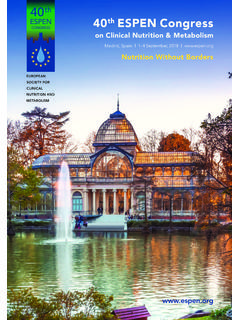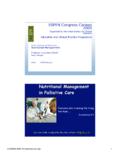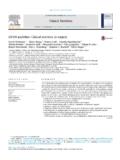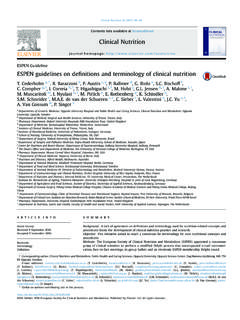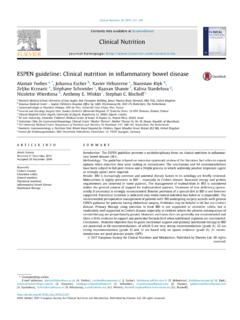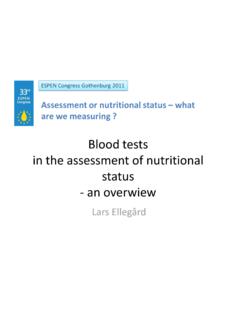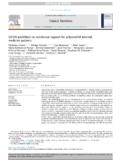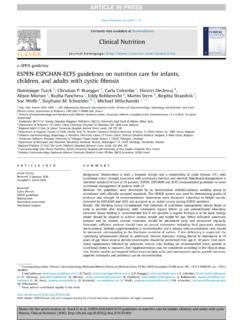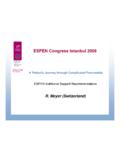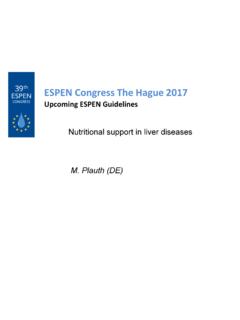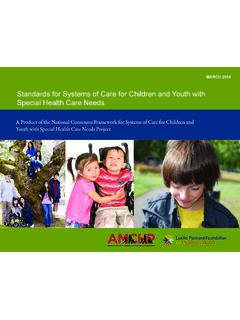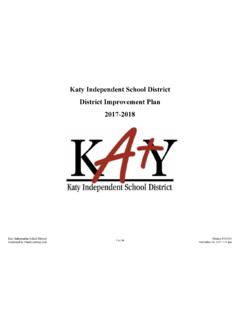Transcription of Protein intake and exercise for optimal muscle …
1 Clinical Nutrition 33 (2014) 929e936. Contents lists available at ScienceDirect Clinical Nutrition journal homepage: ESPEN endorsed recommendation Protein intake and exercise for optimal muscle function with aging: Recommendations from the ESPEN Expert Group Nicolaas Deutz a, *, J rgen M. Bauer b, Rocco Barazzoni c, Gianni Biolo c, Yves Boirie d, Anja Bosy-Westphal e, Tommy Cederholm f, g, Alfonso Cruz-Jentoft h, Zeljko Krznari i, K. Sreekumaran Nair j, Pierre Singer k, Daniel Teta l, Kevin Tipton m, Philip C. Calder n, o a Center for Translational Research in Aging & Longevity, Department of Health and Kinesiology, Texas A&M University, College Station, TX, USA. b Department of Geriatric Medicine, Carl von Ossietzky University, Klinikum, Oldenburg, Germany c Department of Medical, Surgical and Health Sciences, Internal Medicine, University of Trieste, Trieste, Italy d Universit d'Auvergne, INRA, CRNH, Centre Hospitalier Universitaire, Clermont-Ferrand, France e Institut f r Ern hrungsmedizin, Universit t Hohenheim, Stuttgart, Germany f Clinical Nutrition and Metabolism, Department of Public Health and Caring Sciences, Uppsala University, Sweden g Department of Geriatric Medicine, Uppsala University Hospital, Sweden h Servicio de Geriatr a, Hospital Universitario Ram n y Cajal, Madrid, Spain i Department of Clinical Nutrition.
2 University Hospital Center and School of Medicine, Zagreb, Croatia j Division of Endocrinology, Mayo Clinic, Rochester, MN, USA. k Department of Intensive Care, Institute for Nutrition Research, Rabin Medical Center, Beilinson Hospital, Sackler School of Medicine, Tel Aviv University, Israel l Centre Hospitalier Universitaire Vaudois, Service de N phrologie, Lausanne, Switzerland m Health and exercise Sciences Research Group, University of Stirling, Stirling, Scotland n Human Development and Health Academic Unit, Faculty of Medicine, University of Southampton, Southampton, United Kingdom o NIHR Southampton Biomedical Research Centre, University Hospital Southampton NHS Foundation Trust and University of Southampton, Southampton, United Kingdom a r t i c l e i n f o s u m m a r y Article history.
3 The aging process is associated with gradual and progressive loss of muscle mass along with lowered Received 9 April 2014 strength and physical endurance. This condition, sarcopenia, has been widely observed with aging in Accepted 9 April 2014 sedentary adults. Regular aerobic and resistance exercise programs have been shown to counteract most aspects of sarcopenia. In addition, good nutrition, especially adequate Protein and energy intake , can help Keywords: limit and treat age-related declines in muscle mass, strength, and functional abilities. Protein nutrition in Aging combination with exercise is considered optimal for maintaining muscle function. Nutrition With the goal of providing recommendations for health care professionals to help older adults sustain Protein Amino acids muscle strength and function into older age, the European Society for Clinical Nutrition and Metabolism exercise (ESPEN) hosted a Workshop on Protein Requirements in the Elderly, held in Dubrovnik on November 24.
4 Sarcopenic obesity and 25, 2013. Based on the evidence presented and discussed, the following recommendations are made (a) for healthy older people, the diet should provide at least g Protein /kg body weight/day, (b) for older people who are malnourished or at risk of malnutrition because they have acute or chronic illness, the diet should provide g Protein /kg body weight/day, with even higher intake for individuals with severe illness or injury, and (c) daily physical activity or exercise (resistance training, aerobic ex- ercise) should be undertaken by all older people, for as long as possible. 2014 Elsevier Ltd and European Society for Clinical Nutrition and Metabolism. All rights reserved. 1. New insights in aging and declining muscle function * Corresponding author.
5 Center for Translational Research in Aging & Longevity, The natural aging process is associated with gradual and pro- Department of Health and Kinesiology, Texas A&M University, 1700 Research gressive loss of muscle mass, muscle strength, and endurance, , a Parkway, College Station, TX 77845, USA. E-mail address: ( Deutz). condition called sarcopenia [1]. Such changes have been considered 0261-5614/ 2014 Elsevier Ltd and European Society for Clinical Nutrition and Metabolism. All rights reserved. 930 Deutz et al. / Clinical Nutrition 33 (2014) 929e936. Table 1 older adults, , to recommend optimal Protein intake and to Practical guidance for optimal dietary Protein intake and exercise for older adults advise age- and condition-appropriate exercise .
6 Above 65 years. We offer practical guidance for maintaining muscle health and Recommendations physical function with aging (Table 1). We provide our rationale For healthy older adults, we recommend a diet that includes at least g and the supporting evidence for these recommendations in the Protein /kg body weight/day. sections following. For certain older adults who have acute or chronic illnesses, g Protein /kg body weight/day may be indicated, with even higher intake for individuals 2. Changing Protein intake and Protein needs in older adults with severe illness or injury. We recommend daily physical activity for all older adults, as long as activity is possible. We also suggest resistance training, when possible, as part of an Compared to younger adults, older adults usually eat less, overall tness regimen.
7 Including less Protein [4,5]. In Europe, up to 10% of community- dwelling older adults and 35% of those in institutional care fail to eat enough food to meet the estimated average requirement (EAR). inevitable consequences of aging. This concept has recently been for daily Protein intake ( g/kg body weight/day), a minimum challenged, as new study results suggest that mitochondrial intake level to maintain muscle integrity in adults of all ages [6]. At dysfunction, reduced insulin sensitivity, and reduced physical the same time, many older adults need more dietary Protein than endurance are related, at least in part, to physical inactivity and to do younger adults [7,8]. An imbalance between Protein supply and increases in adiposity rather than to aging alone [2].
8 The study Protein need can result in loss of skeletal muscle mass because of a results show that regular exercise can help normalize some aspects chronic disruption in the balance between muscle Protein synthesis of age-related mitochondrial dysfunction, in turn improving muscle and degradation [9]. As a result, older adults may lose muscle mass function [2]. Good nutrition, especially adequate Protein intake , and strength and eventually experience physical disability [10,11]. also helps limit and treat age-related declines in muscle mass, In recent years, an ever-increasing body of evidence builds the strength, and functional abilities. Nutrition in combination with case for increasing Protein intake recommendations for older exercise is considered optimal for maintaining muscle function [3].
9 Adults (Table 2). With the goal of discussing recent research ndings in order to develop recommendations to help adults sustain muscle strength 3. Dietary Protein intake and function into older age, the European Society for Clinical Nutrition and Metabolism (ESPEN) hosted a Workshop with the There are many reasons older adults fail to consume enough ESPEN Expert Group, Protein Requirements in the Elderly, held in Protein to meet needsdgenetic predisposition to low appetite, Dubrovnik, Croatia on November 24 and 25, 2013. This article re- physiological changes and medical conditions that lead to age- and ects practical guidance resulting from the presentations and dis- disease-associated anorexia, physical and mental disabilities that cussions during the workshop.
10 The aim of the workshop was to limit shopping and food preparation, and food insecurity due to provide practical guidance for health professionals who care for nancial and social limitations (Fig. 1) [5]. Table 2. Recent studies on Protein intake and exercise in older adults. Study report Study design and key ndings Gray-Donald Prospective, nested case-control study of healthy, community-dwelling adults older than 70 y et al. 2014 [8] Odds ratio of harmful weight loss in participants with low Protein intakes (< g/kg BW/day) was compared with participants with very high Protein intakes ( g/kg/day) or in participants with moderate Protein intakes ( g/kg BW/day). Tang et al. 2014 [89] Assessment of Protein requirement in octogenarian women using an indicator amino acid oxidation technique (n 6; tested 3-times per person).
